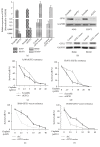Glutathione Peroxidase 1 Promotes NSCLC Resistance to Cisplatin via ROS-Induced Activation of PI3K/AKT Pathway
- PMID: 31032363
- PMCID: PMC6457285
- DOI: 10.1155/2019/7640547
Glutathione Peroxidase 1 Promotes NSCLC Resistance to Cisplatin via ROS-Induced Activation of PI3K/AKT Pathway
Abstract
Purpose: Reactive oxygen species (ROS)-induced cytotoxicity is an important mechanism by which cisplatin kills tumor cells. Glutathione peroxidase family (GPXs) is an important member of antioxidant system which metabolizes intracellular ROS and maintains homeostasis of cells. Altered expressions of GPXs enzymes, especially GPX1, have been described in a variety of human cancers. However, their functional roles in cisplatin-based chemoresistance in human malignancies including non-small cell lung cancer have never been explored.
Methods: A panel of NSCLC cell lines were selected for this study. GPX1 expression was detected using quantitative RT-PCR and Western blot. Cisplatin-induced cell killing was analyzed by CCK8 assay. Intracellular ROS levels were detected by fluorescence-based flow cytometry analysis. In vitro overexpression and knockdown of GPX1 expression were performed using GPX1 expression vector and siRNA approaches. Protein levels of PTEN, NF-κB, BCL2, Bax, and phosphorylated AKT were detected with western blot analysis using specific antibodies.
Results: GPX1 expression was upregulated in a subset of NSCLC cell lines resistant to cisplatin treatment. Expression vector-mediated forced overexpression of GPX1 significantly increased cisplatin resistance in NSCLC cell lines, whereas RNA inference-mediated downregulation of GPX1 could restore sensitivity to cisplatin. Overexpression of GPX1 significantly suppressed elevation of intracellular ROS and activation of AKT pathway when NSCLC cell lines were exposed to different concentrations of cisplatin. Activation of the AKT pathway inhibited proapoptotic cascade and subsequently led to cisplatin resistance in NSCLC cells. Inhibition of NF-κB by its chemical inhibitor BAY can significantly downregulate GPX1 expression and restore the cisplatin sensitivity of the cell lines resistant to cisplatin.
Conclusions: Our findings suggested that overexpression of GPX1 is a novel molecular mechanism for cisplatin-based chemoresistance in NSCLC. GPX1 overexpression blocks cisplatin-induced ROS intracellular accumulation, activates PI3K-AKT pathway by increased AKT phosphorylation, and further leads to cisplatin resistance in NSCLC cells. Inhibition of NF-κB signaling may be an alternative approach for restoring cisplatin sensitivity for NSCLC cells resistant to cisplatin-based chemotherapy.
Figures






References
MeSH terms
Substances
LinkOut - more resources
Full Text Sources
Other Literature Sources
Molecular Biology Databases
Research Materials
Miscellaneous

